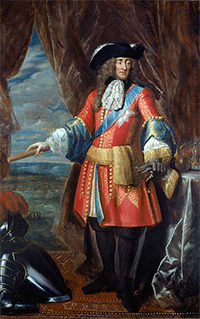The Battle of the Boyne
The Battle of the Boyne was a victory for English forces over Irish forces, for a Protestant king over a Catholic former king. Although the results on the battlefield were not all that conclusive, the symbolic actions resulting from the battle were monumental. 

King James II had fled England in the wake of the Glorious Revolution, which saw the Catholic James replaced on the throne with two Protestants, William and Mary. James still thought that he should be king and had several prominent and powerful people, including France's King Louis XIV, who agreed. In an attempt to regain his throne by force, James landed in Ireland and issued a call for sympathizers to join him. The Jacobite force attacked a handful of Protestant strongholds, without success. Louis XIV sent a few thousand French soldiers to fight alongside James, and England's King William III decided to head up his country's army in response. William and a large armed contingent landed in Belfast and marched toward Dublin. James's army marched from Dublin north and set up a set of defenses along the south bank of the River Boyne, just west of the town of Drogheda. The battle took place on July 11, 1690. 
As things stood, James's force had the upper hand, even though they were outnumbered 36,000–24,000. If the English moved forward, they would have to cross the river while dodging cannon fire and gunfire. William ordered a frontal assault, but only after ordering a diversion. What looked to be a sizable part of the Dutch-English force moved to cross the river at a different point, to the west, a few miles away from the main army. James, wanting to prevent a flanking maneuver, sent a large part of his army to intercept. In reality, William had sent only 7,000 men to the west; the main army remained where it was. William's main army then crossed the river, advancing in the face of attacks from infantry and cavalry, and forced the defending Irish to fall back. Meanwhile, the diversionary force and its Irish counterpart were starting at each other over an impassable ravine; neither army could cross, so no attacks were made and no shorts were fired. James, hearing that the Dutch-English force had successfully crossed the river, ordered a retreat. The rear-guard action protecting that retreat was particularly successful, and the vast majority of the Irish and French troops made it out alive. Casualties resulting from the Battle of Boyne were quite low, all told, numbering about 2,000 (including both sides). Nonetheless, the Irish and French retreated from the field of the battle, and so the victory was William's. Even moreso, James fled again to France. The remnants of his army fought on in his name for another year, but James never returned. |
|
Social Studies for Kids
copyright 2002–2025
David White




